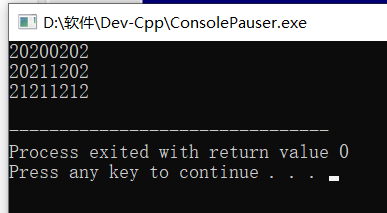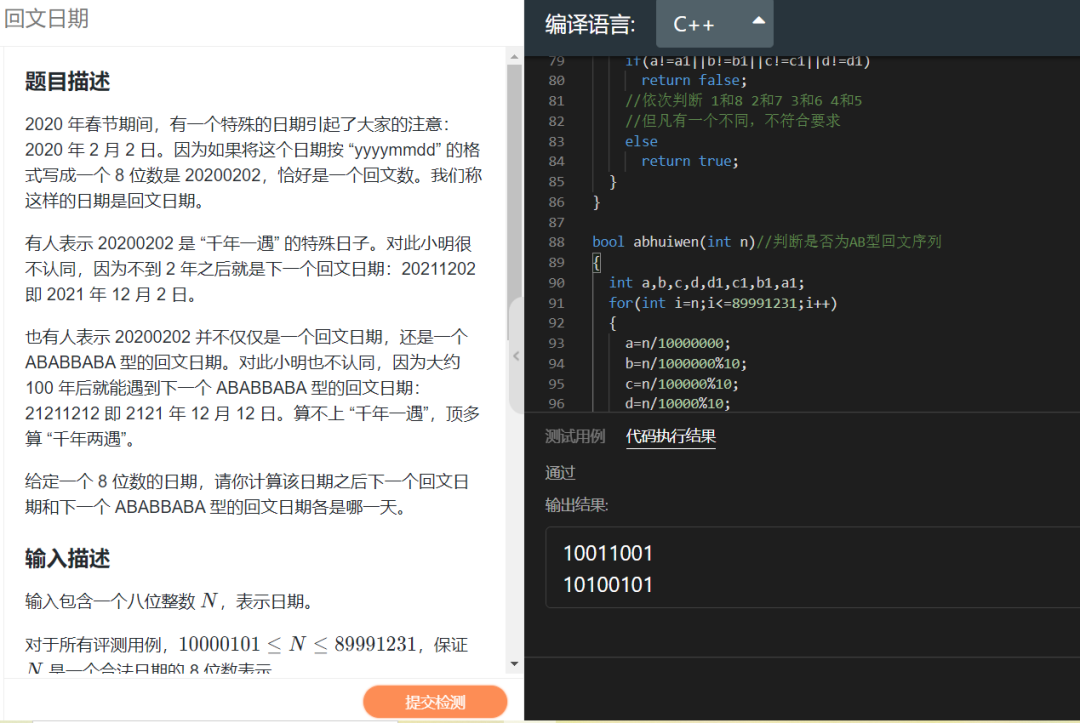Here is the title of the blue bridge cup over the years. Welcome to pay attention to me
[problem description]
During the Spring Festival in 2020, a special date has attracted everyone's attention: February 2, 2020. Because if this date is written in the format of "yyyymmdd", it is 20200202, which is exactly a palindrome number. We call such a date palindrome date.
Some people say that 20200202 is a special day of "once in a millennium". Xiao Ming disagrees with this, because the next palindrome date is less than two years later: 20211202, that is, December 2, 2021.
Others said that 20200202 is not only a palindrome date, but also an abbaba palindrome date. Xiao Ming also disagrees with this, because about 100 years later, he will encounter the next Ababa palindrome date: 21211212, that is, December 12, 2121. It is not "once in a thousand years", but "twice in a thousand years" at most.
Given an 8-digit date, please calculate the next palindrome date and the next Ababa palindrome date after the date.
[input format]
The input contains an eight digit integer N representing the date.
[output format]
Output two lines with one eight digit in each line. The first line represents the next palindrome date, and the second line represents the next Ababa palindrome date.
[sample input]
20200202
[sample output]
20211202
21211212
[evaluation case scale and agreement]
For all evaluation cases, 10000101 ≤ N ≤ 89991231, ensure that N is an 8-digit representation of a legal date.
Topic analysis:
1. Through violence, traverse down in turn and output the number that meets the conditions
2. Use three user-defined functions to judge (date judgment, palindrome sequence judgment, AB palindrome sequence judgment, etc.)
3. The first output meets: Date judgment and palindrome sequence judgment are valid at the same time
The second output is satisfied: Date judgment and AB palindrome sequence judgment are established at the same time
Title Code:
#include<iostream>
using namespace std;
bool judge(int n);//Judge whether it is a normal date
bool huiwen(int n);//Determine whether it is palindrome sequence
bool abhuiwen(int n);//Determine whether it is type AB palindrome sequence
int main ()
{
int n,ans1,ans2;
cin>>n;
for(int i=n+1;i<=89991231;i++)
{
if(judge(i)&&huiwen(i))
{//Meet the date requirements and palindrome sequence at the same time, and output
cout<<i<<endl;
break;
}
}
for(int i=n+1;i<=89991231;i++)
{
if(judge(i)&&abhuiwen(i))
{//Meet the date requirements and type AB palindrome sequence at the same time, and output
cout<<i<<endl;
break;
}
}
return 0;
}
bool judge(int n)//Judge whether it is a normal date
{
int nian,yue,ri;
int yue_[]={0,31,28,31,30,31,30,31,31,30,31,30,31};
nian=n/10000;//Get year
yue=n/100%100;//Get month
ri=n%100;//Get date
if(yue>12||yue==0)
return false;
//If the month screening is not in the range of 1-12, it does not meet the conditions
if(nian%4==0&&nian%100!=0||nian%400==0)
yue_[2]=29;
else
yue_[2]=28;
//Judge the leap year and update the value of February
if(ri>yue_[yue]||ri==0)
return false;
//Filter the date. If it is not in the range of 1 - month end, it does not meet the conditions
return true;
//The remaining conditions meet the requirements
}
bool huiwen(int n)//Determine whether it is palindrome sequence
{
int a,b,c,d,d1,c1,b1,a1;//Corresponding to 8 digits in sequence
for(int i=n;i<=89991231;i++)
{
a=n/10000000;
//Get first place
b=n/1000000%10;
//Get 2nd place
c=n/100000%10;
//Get 3rd place
d=n/10000%10;
//Get 4th place
d1=n/1000%10;
//Get 5th place
c1=n/100%10;
//Get 6th place
b1=n/10%10;
//Get 7th place
a1=n%10;
//Get the 8th place
if(a!=a1||b!=b1||c!=c1||d!=d1)
return false;
//Judge 1 and 8, 2 and 7, 3 and 6, 4 and 5 in turn
//But if there is one difference, it does not meet the requirements
else
return true;
}
}
bool abhuiwen(int n)//Determine whether it is an AB palindrome sequence
{
int a,b,c,d,d1,c1,b1,a1;
for(int i=n;i<=89991231;i++)
{
a=n/10000000;
b=n/1000000%10;
c=n/100000%10;
d=n/10000%10;
d1=n/1000%10;
c1=n/100%10;
b1=n/10%10;
a1=n%10;
if(a==a1&&a==c&&c==c1&&d==d1&&d1==b&&b==b1)
return true;
//Judge whether 1 and 8, 1 and 3, 3 and 6 are equal
//Judge whether 2 and 7, 2 and 4, 4 and 5 are equal
else
return false;
}
}Operation results:

Test results:
